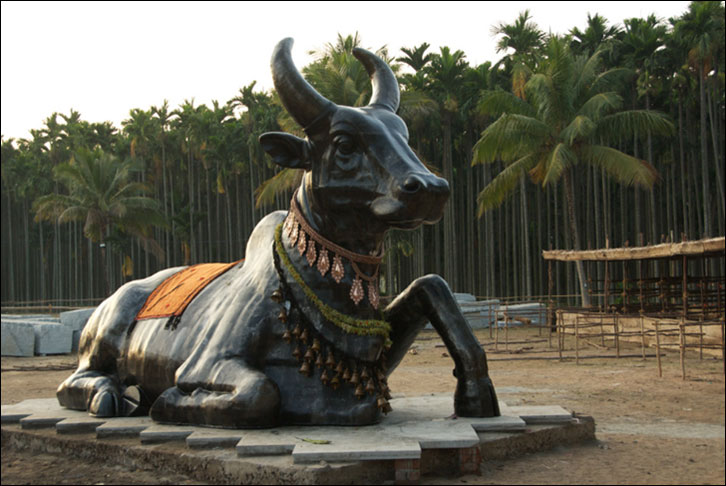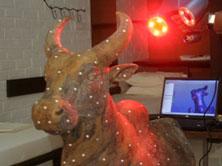VectraFORM Engineering & Solutions Pvt Ltd is a Handyscan 3D distributor based out of Coimbatore in the southern part of India. A couple of years ago, the company came across the opportunity to create a sacred, sculptured bull for the Isha Foundation’s temple.
Did you say nandi?
The Isha Foundation (IF) is a spiritual organization based out of Coimbatore, in the southern part of India, which core activities are a customized system of yoga called Isha Yoga and a mission to implement several large-scale human service projects. In 2008, the Isha Foundation decided to add a nandi to its Shiva temple.
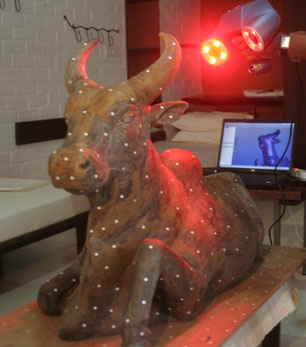
When the project first came up, the Sadhguru of the temple was keen on the idea of having a sacred bull different from those existing across India, and he also wanted it to last more than 500 years. The IF people first thought of a stone or rock nandi, but they previously had their fingers burnt when attempting to build a stone sculpture of Lord Shiva that failed at respecting the original design intent. Because of this, they were looking for a more reliable alternative.
This is when VectraFORM Engineering and Solutions came into play. The company was introduced to the temple managers by a friend. When the IF project leader visited VectraFORM’s premises and saw a demo of the Handyscan 3D technology, he knew he had found the right partners. The deal was sealed.
To obtain the 3D shape of the sacred bull, the team thought of scanning live bulls, but after considering the inevitable issues of dealing with live animals, they settled on taking pictures of various aged bulls and studying their characteristics before combining the best ones to create the final model. Based on pictures and within a month, the temple sculptors crew created a plaster of Paris model, striving to imitate the position when the bull tries to stand up from a lying position. When doing so, it usually brings up one of its front legs and pushes its back up. This position was chosen because it also indicates that the bull is “recognizing the master before him”.
Technology and religion: a very good match!
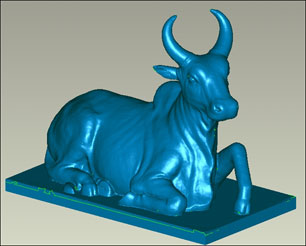
At this point, the wax replica was scanned using a Handyscan 3D handheld and self-positioning laser scanner. Once the optimal laser power and aperture time settings were determined for this particular surface, the scanning process required about 5 hours of work, plus 16 hours of post-treatment to assemble the various scans. The team used VXelements to export the .STL file in binary format, and imported the model into Rapidform and Geomagic for post-treatment and assembly. Since the model’s underneath wasn’t scanned for technical reasons, the model was filled using the post-treatment software to make it watertight. Then, it became possible to calculate some critical data, such as the bull’s surface area.
The initial plan was to cast the entire body, but at this point, the team faced some issues such as a limited number of technical foundries within the region, and the budget available for the project. Finally, it was decided to ensure good quality and maximum lifetime of the sacred bull by having the head cast, and the body manufactured using mild sheet.
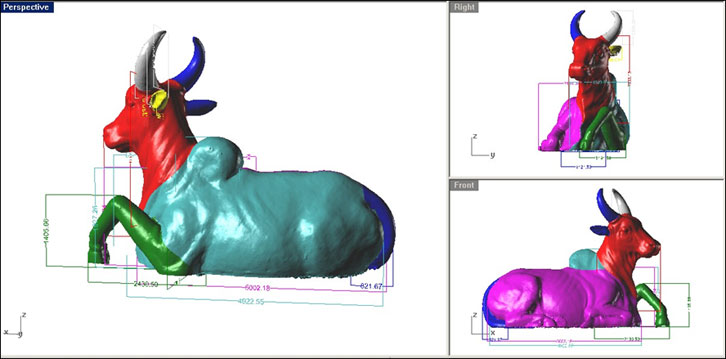
Building the Skeleton

However, the most important piece was missing: the head. Manufactured in another location, 500 km away from the site, the head was cast in 7 pieces, and all of them were welded and assembled on-site. Supporting bars were used to help compensate the deformation or warping of the castings, and a 100-mm buffer zone had been planned in anticipation of the head and torso assembly. This way, it would still be possible to make the whole thing work even if faced with slight dimension variations between the manufactured skeleton and the cast head.
The Sacred bull was inaugurated before 250,000 people by the Sadhguru (the chief priest) of the temple on February of 2009, during a special day. It is now known as the Nandi Shrine in the temple.
Contribution of the Handyscan 3D technology
The Handyscan 3D laser scanning technology contributed greatly to the Nandi project and helped generating astonishing results. Despite the considerable actual size of the statue, the high accuracy obtained on the 2 ft-tall plaster model with the Handyscan 3D scanner allowed for very detailed and realistic rendering on the 12 feet metal statue. All of this definitely contributed to the nandi’s “wow factor” – a very important aspect for the temple people, which goal was to honor their deities by building a realistic, lasting statue, while attracting more worshippers.
